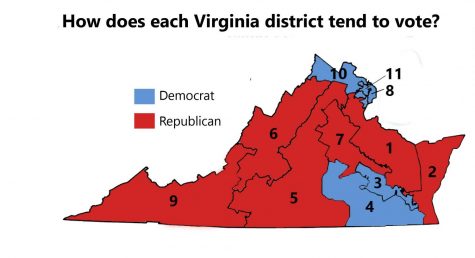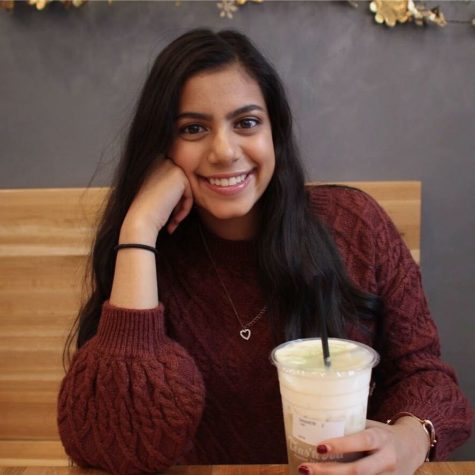A classroom divided
Students and staff weigh in on the political divide in classrooms
March 26, 2019
“You’re a bigot. You’re racist. You’re sexist.”
These serious generalizations are frequently heard in the school’s classrooms and hallways, referring to students. The justification for such statements, however, is often merely the fact that these people hold conservative beliefs. Classrooms meant to be a safe space to share opinions are becoming hostile environments for many.
“When the Young Republicans [segment] played [on the Knightly News], there were a lot of students in my first period class ridiculing it and making fun of the people in Young Republicans just because they were a part of the Republican group,” junior Emory Hinkle said.
The majority of the student body seems to maintain some variation of the liberal viewpoint, at least in class discussions, which contrasts with the historically large Republican majority in Virginia.
“I think that there is a liberal majority at the school, especially since a lot of the students I interact with are very open about their liberal and progressive mindsets,” senior Aditi Mahabal said. “I know that teachers are not supposed to be outward about their political beliefs, but I definitely get the vibe that the majority of them are liberal based off of their reactions to current events.”
This perceived Democratic majority in the school reflects the distribution of political ideology in Northern Virginia (NoVa), which also maintains a liberal majority. Many accredit this to the large immigrant and minority populations in the region, which tend to vote Democrat. NoVa accounts for almost 60 percent of Virginia’s population growth, according to the Washington Post, and with such a high population density, NoVa voters play a large role in electing Democratic candidates despite the Republican majority in the rest of the state.
“I think it is an unintentional happenstance of demography and the fact that Northern Virginia is becoming more urbanized or completely suburbanized than it had been in the late 90s and early 2000s,” AP Comparative Government teacher Matt Stoner said.
This observation has not gone unnoticed by the student body, and many students and staff recognize that conservative students may feel unable to express their opinions. According to some, this issue isn’t always obvious, but is instead an unexpressed social implication.
“I am sensitive toward an unspoken tension or discomfort among people of the right or more conservative ideology,” Stoner said.
The seemingly closed-minded attitude regarding students with differing political views, however, is not reserved solely for conservative students. Many also feel that liberal students are sometimes silenced.
“As much as people try to criticize conservatives, I think that conservatives criticize liberals as well,” Mahabal said. “They will call liberals ‘snowflakes’ or say that they are too sensitive. They’ll sometimes say that left-leaning news outlets are ‘fake news.’”
There are several reasons for the perceived discrimination against students of certain political ideologies. According to some, it has to do with stereotypical beliefs people associate with each political party.
“Some people are offended by political views held by students that could offend or infringe upon people’s sense of identity,” senior Grady Jones said.
Other times, students believe people are upset not by what others believe, but by the way they choose to express their views.
“I have seen some students be criticized; however, I’ve noticed that that criticism is more based off of how they express their views rather than what they say,” Jones said.
Others believe that students feel pressured by their peers and teachers to project a more liberal viewpoint, leading to conservative students becoming the minority population.
“I often feel that this school community tries to push its views on me and kind of guilt conservative leaning students,” Hinkle said.
The Fairfax County Public Schools Student Rights and Responsibilities handbook states that students have the right to “express opinions freely through speech, assembly, petition and other lawful means.” However, many students feel they are unable to exercise this right due to potential backlash from their peers.
“A lot of people are scared to speak out; they no longer feel comfortable doing so because they’ll be ridiculed or targeted or made fun of,” Hinkle said. “A lot of conservatives have been shamed into silence, so we go on believing what we do in silence.”
The apparent lack of conservative representation in NoVa and the school community specifically can lead to an absence of education about both sides of the spectrum on key political issues.
“People are afraid in some instances to share their views, and that creates a real lack of discussion,” Jones said.
However, many believe that the situation can be remedied through a slight change in perspective.
“I think that if we’re kinder and more accepting of other people’s opinions, then we can remedy the current situation and create a more positive learning environment,” Jones said.
Additionally, others suggest that teachers can help foster a more neutral classroom environment through facilitating discussion and encouraging students of all ideologies to share their views, creating venues for equal expression of opinions.
“I think the teacher must create a neutral environment by not showing favoritism toward any one side or another and by offering both ideologies a fair opportunity to express their points of view,” Stoner said.
Students and staff agree that in order to ensure progress and a safe classroom environment, the silencing of students’ opinions must end.
“There is a lack of open-mindedness regarding political beliefs in the classroom and it is a growing problem because it means that a lot of important voices that need to be heard are being silenced under other people’s very strong opinions,” Mahabal said. “If we want to have change, then we need to take a step back and listen to each other.”




